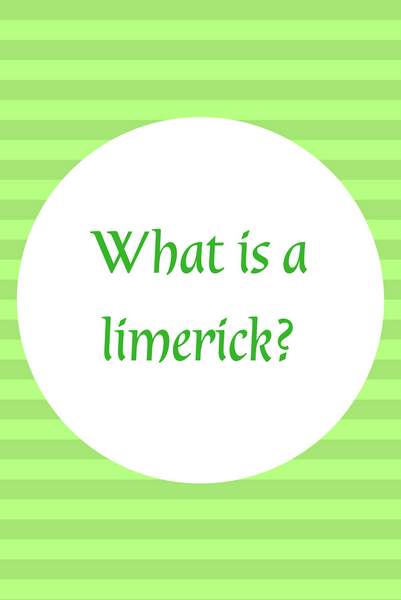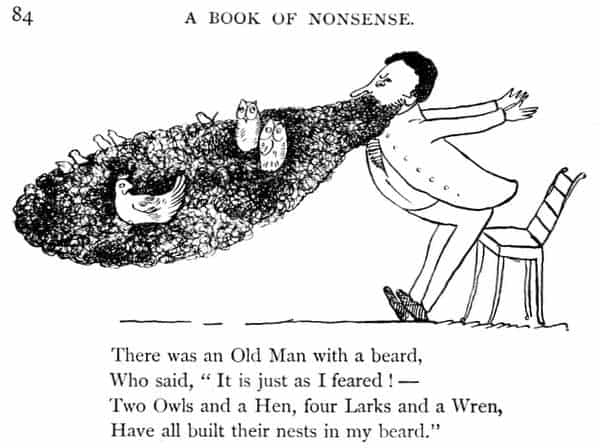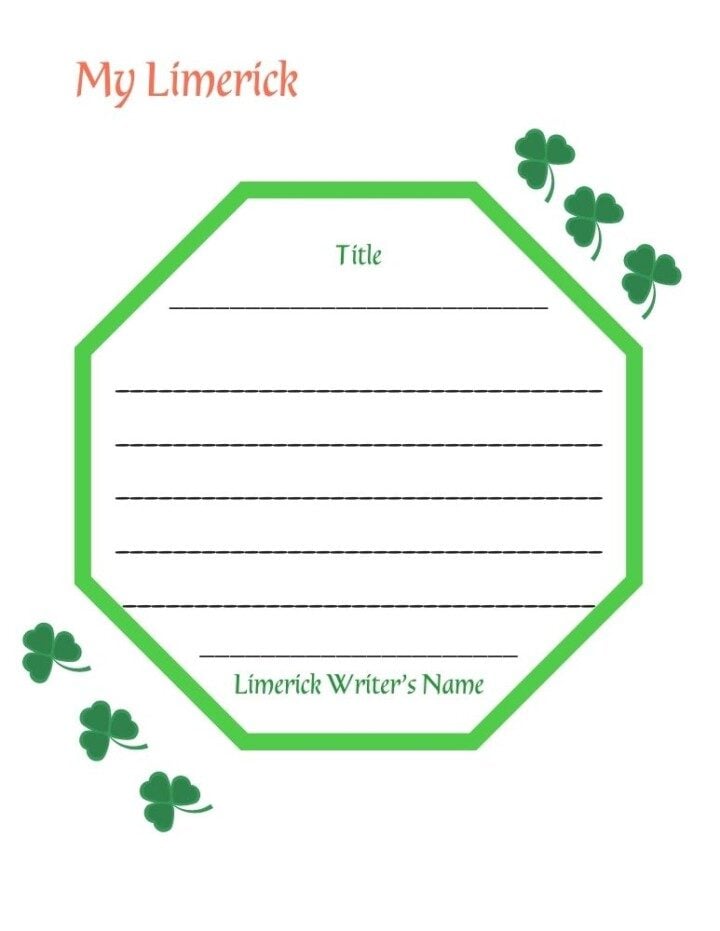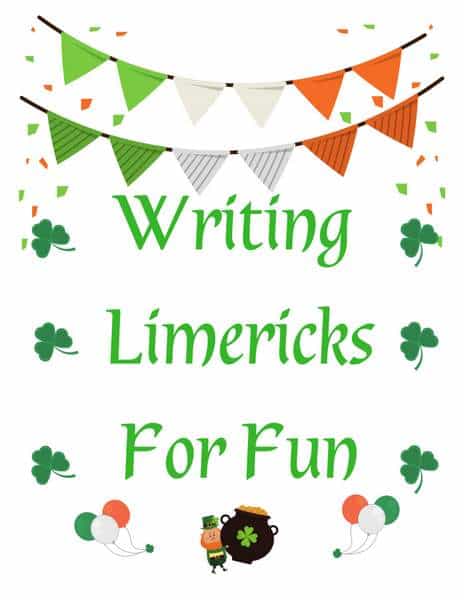Have you ever wondered what is a limerick? How did limericks, those short, five-line rhyming ditties come to be named after one of Ireland's counties?
I recently completed a post taking readers on a photographic tour of County Limerick, and as I was creating this piece I started wondering about the origins of these infamous little "Irish" poems.
Are they really Irish?
How did the name limerick come to describe these comical verses?
What has County Limerick got to do with these ditties?

Table of Contents
An Introduction to Limerick Verses
These questions were spinning around in my head as I wrote about County Limerick, so I thought it was a perfect time to explore the history and development of the limerick, Ireland's most popular form of poetry.
Who doesn't love a well composed limerick? They can be utilised as a form of comedic outlet, and for anyone who loves satire, then the limerick is a perfect way to pen your satiric intent.
At the end of this post, I've also included a free resource for parents, grandparents or teachers who would like to inspire their kids to turn a hand to writing their own limericks.
Or if you've no kids to encourage to write, perhaps you would simply like to write a few limericks yourself. Save and print away, if that's the case.
But before we take to writing our own limericks, let's first learn a bit about the history of this poetry form.....
What Is A Limerick?
A Limerick is a short, five-line verse that follows a strict rhythm and rhyming pattern. The first, second and fifth lines rhyme with each other and have three phrases of three syllables each.
The third and fourth lines also rhyme with each other, but are shorter, having two phrases of three syllables.
This traditional rhyming scheme is what makes a limerick unique, and true to form. Remember the pattern is AABBA.
In traditional format the first line introduces a person and/or a place. The main character's name or the place name in question usually appears at the very end of the first line, establishing the rhyme for the second and fifth lines.
Let's get a little technical as we describe these limerick rhyming patterns.
Limericks are written using anapestic meter. This is when two unstressed syllables are followed by a stressed, third syllable. In lines one, two, and five of a limerick you will find three anapests, while the third and fourth lines feature two anapests. And remember all this time you are following the rhyme scheme of aabba.
Early limericks usually utilized repetition of the first line as the fifth linerhym, but overtime greater emphasis has been placed on a unique, punch-line packing finale for these little ditties.
Think of limericks as humorous poems, but this does not mean free reign in their creation.
Always stick to their straightforward structure and the strict compositional elements outlined above.
They often start with the phrase "there was a young fellow," or "there was a young lady" from....
And remember the subject of the first line is usually repeated in the last line.
Who Made Limericks Famous?
Edward Lear was an English artist, illustrator, writer and poet of the 19th century. In 1846 he published his Book of Nonsense, a compilation of short limerick poems. Here is one example of his witty verses ...
"There was a Young Lady whose bonnet,
Came untied when the birds sat upon it;
But she said: 'I don't care!
All the birds in the air
Are welcome to sit on my bonnet!'"
~ Edward Lear 1846

There was an Old Man with a beard,
Who said, “It is just as I feared!—
Two Owls and a Hen,
four Larks and a Wren,
Have all built their nests in my beard.
Edward Lear
The limerick was popularized through Lear's book and Victorian England adopted the format, creating their own little ditties for entertainment.
Here's another example of Lear's work...
There was an Old Man of Kilkenny,
Who never had more than a penny;
He spent all that money,
In onions and honey,
That wayward Old Man of Kilkenny.
~ Edward Lear 1846
Here's another example of Lear's work.
There was a Young Lady whose chin,
Resembled the point of a pin;
So she had it made sharp,
And purchased a harp,
And played several tunes with her chin.
~ Edward Lear
Other famous 19th century authors also enjoyed writing limericks including Ogden Nash, Isaac Asimov and the American writer Mark Twain. James Joyce, Rudyard Kipling, and Lewis Carroll also penned a few of these Irish rhymes.
Although Lear spread the word about limericks far and wide, he was not the original creator of this art form.
As the name suggests the first writers of these ditties were Irish.
Who Wrote The First Limericks?
The river Maigue flows near the town of Croom, home to Seán O Tuama, a local publican and poet. His good friend and customer was Aindrias Mac Craith, another member of the Maigue poets.

Now Seán wrote a little poem one evening about himself as an inn-keeper.
"I sell the best brandy and sherry
To make my good customers merry.
But at times their finances,
Run short, as it chances,
And then I feel very sad, very."
~Seán O Tuama, 18th century Irish poet
Now, Seán's good friend Aindrias took exception to this poem, assuming it was directed at him and his growing tab at the alehouse.
And so, like any good poet, he picked up his quill, and penned the following retort...
"O Tuomy! You boast yourself handy
At selling good ale and bright brandy.
But the fact is your liquor,
Makes everyone sicker,
I tell you that, I, your friend Andy."
"Both your poems and pints by favour,
Are alike wholly wanting in flavour:
Because it's your pleasure
You give us short measure,
And your ale has a ditch water flavour."
~ Aindrias Mac Craith, 18th century Irish poet.
We don't know how long this Irish grudge lasted between the two men, but when he died in 1775, Seán was keenly mourned by Aindrias.
And that's how limericks were born, out of a grudge over alehouse debts, which I suppose makes them truly Irish.
You can read all about the Poets of the Maigue, in this book by Mannix Joyce. Thanks to Limerick library for making it available online.
Keeping Limericks Clean
Now many a limerick has been written since the Maigue poets first wrote their friendly or not so friendly jibes.
However, over the years many, many limericks have been written that don't meet editorial standards for this little corner of the world wide web.
The old man of Nantucket rhymes with an infamous Irish curse (find out why the Irish love to curse).
Here we strive to keep the written word wholesome, and there's many a limerick that's far from wholesome.
This little limerick sums up the humorous side of these little ditties ...
There was a young schoolboy of Rye,
Who was baked by mistake in a pie.
To his mother’s disgust,
He emerged through the crust,
And exclaimed, with a yawn, Where am I?
Here's another clean limerick...
"The limerick packs laughs anatomical
Into space that is quite economical.
But the good ones I've seen
So seldom are clean
And the clean ones so seldom are comical."
~ Leonard Feinberg, The Secret of Humor, 1978.
Here's a good one displaying the humor and skill of good limerick writing ...
"There once was an old man of Lyme
Who married three wives at a time.
When asked, “Why a third?”
He replied, “One's absurd!
And bigamy, sir, is a crime.”
~ William Cosmo Monkhouse (1840 - 1901)
And that's all I'm going to say about the ribald humor that finds expression through this Irish verse form.
Famous Limericks Over The Years
Here's one of the most famous limerick's in the world ....
"There once was a man from Nantucket,
Who kept all his cash in a bucket,
But his daughter, named Nan,
Ran away with a man,
And as for the bucket, Nantookit"
~ Old American Limerick
Here's one you may not realize is based on the limerick, but it's one of the most famous English nursery rhymes.
“Hickory dickory dock.
The mouse ran up the clock.
The clock struck one,
And down he run.
Hickory dickory dock.”
~ Andrew Lang, The Nursery Rhyme Book, 1897
The number of syllables in each line is a little shorter than usual, but the AABBA rhyming pattern is based on a limerick.
And so you see, the limerick truly is a versatile little verse format.
Write Your Own Limericks
And so, why not take a hand to composing your own little limericks.
I remember getting limerick writing homework as a child. I dare say the nuns got quite a chuckle from some of our Dublin poetry back in the day.
Here's my recent attempt at a limerick to describe my blogging endeavors...
"There was an old dame in Kentucky
Who at writing was quite a rookie,
She dreamed up a blog
While out for a jog
And now she is ever so lucky."
Now I'm not known for my jogging abilities, but I desperately needed a rhyme for blog, so I adhered to the old Irish words of wisdom.... never let the truth get in the way of a good story.
Here's another recent composition ...
"There was an old man called McCarney
Who was born in the small town of Blarney
He never stopped talking
Even when he was walking
How we wish he was born in Killarney."
We could get carried away writing limericks.
However, I believe it is a great way to introduce kids to poetry, rhyming and rhythm, and many teachers utilize limericks in the classroom to this very day.
Free Limerick Writing Worksheets To Save and Print
For anyone who would like a lesson plan about limericks I created a free printable for saving and printing.
It includes some Irish themed framed templates for any hopeful limerick writers to record their poetry.
Feel free to share this link with friends, family and any teachers or homeschooling parents who may find these sheets helpful.
If you're interested in taking a tour of County Limerick check out my photographic tour including information on the River Shannon, King John's Castle, the Hunt Musuem. There are plenty of travel tips included too.
Happy limerick writing to all!

Slán agus beannacht,
(Goodbye and blessings)
Mairéad -Irish American Mom
Pronunciation - slawn ah-gus ban-ock-th
Mairéad - rhymes with parade
Here are some county tours around Ireland which you may like to check out ....





















T.M. Johnson
Ah, the limerick, IAM. What delightful "doggerel" 'tis. Interesting that while Edward Lear is best known for his limericks, his were perhaps the least creative. I have in my library a delightful book on the subject: The Lure of the Limerick: An Uninhibited History by William Baring-Gould (Clarkson N. Potter, Inc., 1967). The book includes limericks from A-Z, the limerick laundered, and as the limerick lends itself to smutty graffiti: the limerick "unlaundered" (which, I venture to say is a large percentage of them):
The limerick is furtive and mean;
You must keep her in close quarantine,
Or she sneaks to the slums
And promptly becomes
Disorderly, drunk and obscene
In keeping with the subject matter the book includes the "bawdy" artwork of Andre Domin and Aubrey Beardsley.
As a young lad the structure of the form had such appeal, I recited the following at a "show and tell" session in the early elementary grades and if memory serves was rewarded for the performance by a handwritten note to be delivered to my mother:
A grand old bird is the pelican;
His beak holds more than his belican.
He can hold in his beak
Enough food for a week,
But I'm darned to see how the helican.
And my grandson has mastered the following:
There was an old man from Peru
Who dreamed he was eating his shoe.
He awoke with a fright
In the middle of the night
And found it was perfectly true.
Perhaps I should have chosen that one all those many years ago. TMJ
Irish American Mom
Hi T. M. - I just knew this post would be right up your alley. I love the limericks you've added to our little collection. I remember the pelican one from my childhood. It's by Ogden Nash, I believe. I too was known for reciting the wrong piece on many occasions. I scandalized a birthday party with my sister, when we delivered the following little poem -
"There was a little man, and he had a little gun,
And over the hill he used to run.
He had a big tall hat,
And a belly full of fat,
And a pancake stuck to his bum, bum, bum."
And that little ditty is in limerick format too. The birthday girl's mother informed my mom she wasn't too keen on our choice of party pieces.
Take care, and have a lovely week. Always great to hear from you here.
All the best,
Mairéad
Cindy Thomson
Thanks! I'm often looking for fun writing activities for kids!
Irish American Mom
That's great, Cindy. Encouraging kids to write is so important, especially in this age of technology, which only encourages brevity and limited expression. Thanks for stopping by.
All the best,
Mairéad
Cheryl Barker
Wow, Mairéad, so much I didn't know about limericks! 🙂 I especially love the old Irish wisdom you shared - Never let the truth get in the way of a good story. Ha! 🙂
Irish American Mom
I always like that one too, Cheryl. Limericks have quite a history and it's nice to know they may have actually had their origins in County Limerick.
All the best,
Mairéad
irishnannie
Mairead, this is wonderful!
I never knew all the history of the limerick, but I LOVE rhyming, so I am going to have fun with all this!
And with my grandchildren who are absolutely so fun when it comes to doing things together, they are going to love this.
Always learning things from you, Mairead!
Always thank you and God bless you!
Irish American Mom
Happy limerick writing Irishnannie. I hope your grandkids find their inner Irish poet.
All the best,
Mairéad
Jeff
Mairéad,
I just came across your limerick writing material. I'm going to give it try and see what I can mess up!
Thanks!
Irish American Mom
Best of luck with your compositions, Jeff.
Take care,
Mairéad